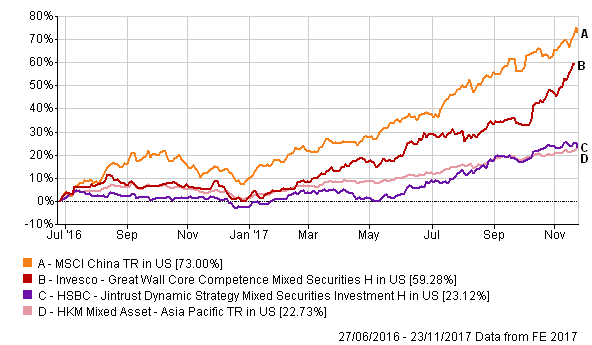The FSA Spy market buzz – 30 May 2025
Korean AI-driven investing, The wisdom of Nvidia, Goldman Sachs and active good news, The sheer size of the top ten, Ferris Bueller and Trump’s tariffs, A trillion here - a trillion there, and much more.

Performance of the two funds since June 2016 – the earliest data available – vs the MSCI China Index and the category average
Although both funds lost value in 2016, they have delivered positive returns since 2013. Their five-year performance is virtually identical. Both more than tripled in value during that time.
The ability of the HSBC Jintrust fund to quickly react to market conditions proved beneficial during the period of extreme volatility in 2015, Li said. The fund lost around one-third of its peak 2014 value and has since surpassed it. That compares well to the IGW fund, which lost around half of its value from the peak in mid-2014, and hasn’t yet fully recovered.
The HSBC Jintrust states that its benchmark is composed of 50% of the MSCI China Index and 50% of the China Bond New Composite Index. But it is only pro forma, according to Li.
“Very few Chinese fund managers follow a benchmark,” he said. “Chinese mutual funds are very much like hedge funds in the US,” he added.
| HSBC Jintrust | Invesco Great Wall | Morningstar China Large Cap CNY Index | |
| 3-year return (ann.) | 31.28% | 28.22% | 14.87% |
| 1-year return | 19.67% | 43.95% | 19.46% |
| 3-year Alpha | 15.04 | 13.02 | |
| 3-year Beta | 0.97 | 0.87 | |
| 3-year Sharpe Ratio | 1.02 | 0.83 | |
| 3-year Volatility | 27.96 | 21.94 | 11.48 |
Data: Morningstar, 31 October 2017, returns in US dollars, returns and ratios are annualised
 Impact opportunities: investing to limit biodiversity loss
Impact opportunities: investing to limit biodiversity loss
 Smartphones on wheels
Smartphones on wheels
 The year of living dangerously for income investors
The year of living dangerously for income investors
 Dynamism is the name of the game for this global macro strategy
Dynamism is the name of the game for this global macro strategy
 Sourcing resilient yield and income through short-dated credit
Sourcing resilient yield and income through short-dated credit
 China bonds: plugging the yield gap
China bonds: plugging the yield gap
 Tap into Japan’s post-pandemic growth trends
Tap into Japan’s post-pandemic growth trends
 How can a sustainable approach also ensure you don’t compromise performance?
How can a sustainable approach also ensure you don’t compromise performance?
 Unmasking the dividend opportunity
Unmasking the dividend opportunity
 Turning environmental hopes into investment reality
Turning environmental hopes into investment reality

Korean AI-driven investing, The wisdom of Nvidia, Goldman Sachs and active good news, The sheer size of the top ten, Ferris Bueller and Trump’s tariffs, A trillion here - a trillion there, and much more.
Part of the Mark Allen Group.
